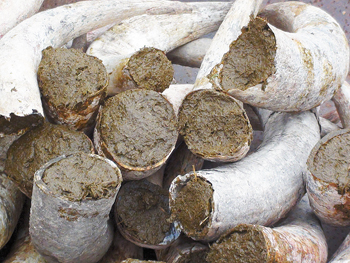Friends of Life in the Boomer Lane belong to a food coop. When they are out-of-town, she and Now Husband receive their share (30lbs of root vegetables). Or an extra loaf of bread. The bread (and everything else), she was informed, was the product of biodynamic farming.
LBL, plunk in the middle of her annual warm weather tour of local ice cream emporiums, hadn't been keeping up with the world of anything sprouting from the ground. LBL's friend continued explaining that the bread LBL's Now Husband was eating, as well as all the root vegetables LBL and Now Husband had consumed, grew in soil prepared with a ram's horns filled with poop.
LBL decided to do some hard research. She started with the Internet.
Biodynamics as an agricultural science began in Europe in 1924, probably by someone trying to find uses for rams' horns and poop. It has quietly grown and become more accepted as people increasingly turn their back on conventional agriculture. Biodynamics treats the farm as a functional ecosystem, a unique, living entity, just like the people who inhabit the farm are. The healthier the ecosystem is, the healthier the production should be.
"Instead of growing a monoculture, which nature abhors," complementary plants are arranged around a crop. In other words, plants take care of other plants. To control rodent and other pests, hawks, kestrels, and owls are lured in with free housing, perches, or nesting trees. One hawk can patrol about 500 acres and significantly reduce crop damage from European Starlings. All animals have their place in the ecosystem, whether as food providers or as contributors to the health of other animals. All problems are taken care of by the ecosystem, itself, without the use of chemicals or anything artificial. A biodynamic farm is a perfect universe, just as ours would be if everybody were allowed to do exactly as they were intended to do by nature, expect for thugs, inept salespeople, and Tea Partiers.
Lest you think that the biodynamic universe limits itself to a small parcel of land, you should know that biodynamic teachings also include a spiritual and mystical perspective. It also recognizes, and allow for, influences coming from outside the planet: not just the sun and moon but also the planets of the solar system and the constellations.
LBL knows what you are thinking: This is all well and good, Life Whoever-You-Are. But I'm not here for a farming lesson, much less anything about birds or aliens on other planets controlling my food supply. If I want to eat a Big Mac, I really don't care that the lettuce and tomato were influenced by the moon. Your title got me here, so where does the ram's horn and shit come in? I could be reading someone else's blog that is filled with scatological humor and cartoons to go with it. Give it to me now or I click onto someone else's post.
To you, LBL says: You are an ingrate with the attention span of an elected official. And LBL said nothing about aliens (although she was thinking about it.) But LBL is stuck with you as her reader, and she does appreciate that you read her posts even though she doesn't know how to put cartoons or videos on them, so she will attempt to get to the punch line :
One of the ways that biodynamic farmers prepare the soil for the joyful and most likely titillated reception of seeds is to bury a lot of rams' horns filled with manure. LBL has thus far been unable to find out why it has to be a ram's horn (although she suspects the original procedure started back at a time when most people had two rams in every garage) and why it has to be filled with shit and if the planting has to be by the full moon or if there is any chanting or nudity or group sex involved. Then there's the stuff to do with sticking other stuff in deers' bladders and hanging them in trees. LBL won't even get into that part.
A second component is the crushing of a variety of organically grown flowers, mixing this into extremely large dung heaps, and scattering the result all over the field.
Having exhausted her 10 minute allotment of Internet research, LBL's next step was research out in the field (not the dung field.) She visited her local Safeway and asked the manager how many ram's horns were sold each month, and if the larger horns were more popular because they could hold more feces. The interview was terminated when the local constabulary appeared and dragged LBL away.
She then visited another supermarket chain, asked the same questions and was encouraged to buy a package of beef jerky. "Looks and tastes the same as poop," she was informed. Instead she declared her research at and end and went to the ice cream section to consider the new line of gelato.

